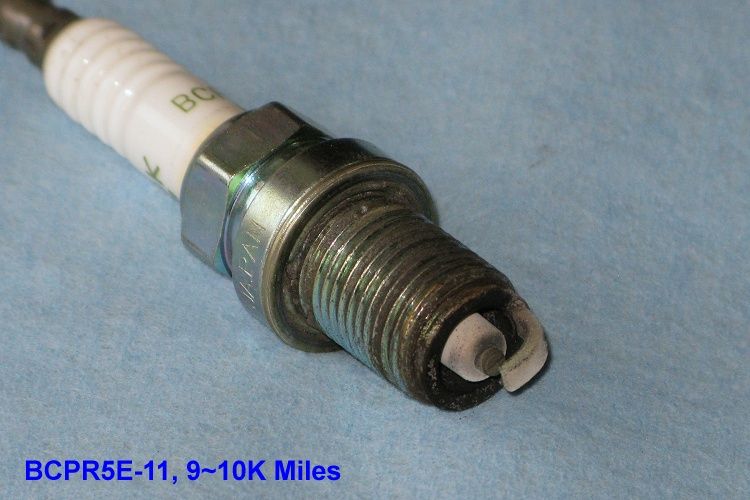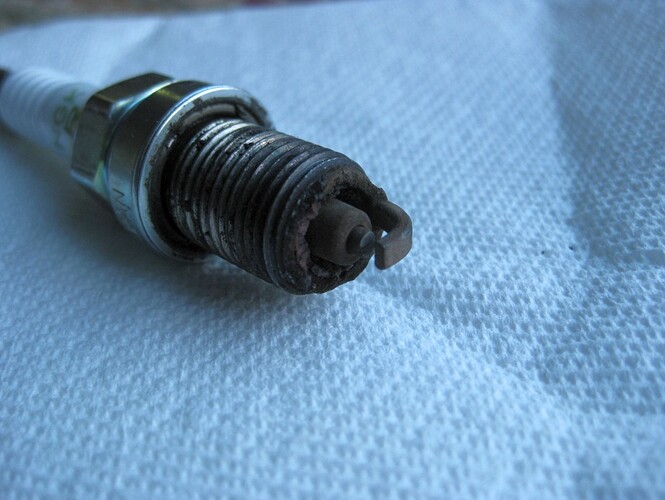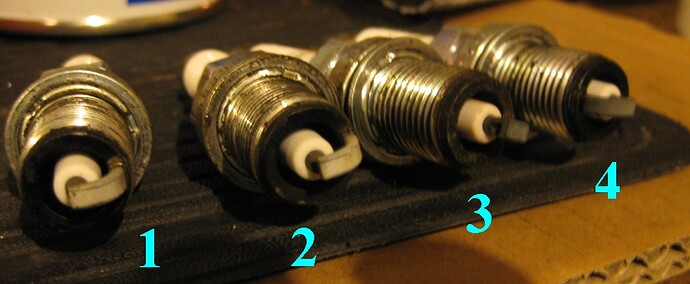I can’t seem to find this damage on any of the “spark plug fouling” charts. Anyone have any ideas? On a side note, compression is good in this cylinder.
Looks like burnt oil from a bad valve seal.
Good picture, but it is still a little hard to tell if those are deposits on the outside, or if the plug is eroded away.
Do you know how old the plugs are, and replaced by you or someone else?
(a PO might have left an old plug if it was hard to get out)
In any case, some plugs are not easy to read, and you may have to put a new set in, run them for a thousand miles or so, and reinspect.
It has been eroded. There’s between 5-8K mi on them. I replaced these myself. This was the only noticeably bad one. Wondering if this is what keeps causing the bad idle. The shop says I have bad oil seal in the cylinders (requiring an engine re-build) but I always like to get second opinions.
[QUOTE=N FUL FX;2321451]It has been eroded…[/QUOTE]Eroded at <10K miles suggests running lean and/or hot. Eroded on only one cylinder suggests a problem with the fuel supply to that cylinder, like a partially clogged fuel injector.
At idle the fuel supply is much less, so that one cylinder may be hardly firing at idle. At normal driving speed when the fuel supply to that cylinder increases, the cylinder may not be missing, just running lean.
Not sure how much effort you want to put into diagnosing this, but you could could confirm if that cyl is missing, and if it is, swap fuel injectors between cylinders, etc… new injectors may be pricey to throw in just to see if it goes away.
If the oil seal in the cylinders is bad, wouldn’t you have low, or uneven compression on at least some of the cylinders, or other signs or burning oil??
I think I’m definitely burning oil because I do smell something odd at high acceleration and I also change much less oil (maybe like 3qt) with oil changes.
My compression test ran 185 185 179 185
[QUOTE=N FUL FX;2321456]I think I’m definitely burning oil because I do smell something odd at high acceleration…[/QUOTE]That is more like an exhaust leak at the front of the car, which gets sucked into the cabin. A quart between oil changes on such an old car is not a big deal. I lose that much from two small oil leaks, one at the cam end plug, and one at the oil pan gasket, so I would check for small oil leaks.
Seems like really good compression numbers at 325K miles! ![]()
you won’t lose compression from a bad/stuck oil control ring. how did the original plug look? the one that you replaced with this one
Understood about the oil leaks. I do have one around the distributor. Okay, perhaps I’m not burning it.
I got a second opinion at Honda and THEIR compression numbers on my car ran way low: 135, 131, 129, 135 (If I remember correctly). I don’t know why the two shops have different compression numbers when one was before spark plug replacement, and one after. :shrug:
Sorry welfare, I don’t understand what you’re asking. I replaced those plugs with new ones.
The car has been running okay since, but I haven’t taken it very far because I’m afraid to damage anything.
sorry, i guess it was a bit unclear. i meant what did the original plug from that cylinder look like. before you replaced them. if you can recall.
as for the compression numbers, i wouldn’t worry much. the procedure was probably performed incorrectly. maybe with a low battery or throttle not open. as per spec, 185 is nominal. while 135 is the minimum. if you had 2 cylinders below spec, as the second recording indicates, you would definitely know it
if you can recall that the original plug looked fine, i would just monitor it. maybe pull it out in 1k. if it looks good still, pull it out again next oil change. if you don’t see anything peculiar, i’d chalk it up to a bad plug.
Usually if a spark plug is eroding it is because the engine, (or at least the cylinder in question), is running very lean and/or very hot. When Ive seen that, the electrode erodes b/f the outer ring does.
In this pic above the electrode looks intact, and the whole plug end is covered with some kind of dark residue, which is usually from running cold and/or rich, or possibly oil-fouled. I personally cannot tell the diff between carbon and oil from a pic, only from examining/touching the residue when the spark plug comes out of the engine.
So, I would try to scrape some of the crud off the outer ring and the electrode using a small screwdriver, b/c one can then tell if its carbon deposit, or actual erosion. (some people use a small wire brush to be sure) If its just carbon, and after less than 10K miles, an intact flat shiny surface will show under the crud on the outer ring (not the electrode, that usually can’t be cleaned and look shiny)
If there is so much oil going into a cylinder that the engine needs a rebuild, like from a damaged third piston ring, and the engine is burning a lot of oil, you can see it in the exhaust after the engine is warmed up. The exhaust looks blue, and smells like burning oil, and even a new plug will be covered in oil when you take it out after just a few miles. This does not take long to show up on the end of a plug, unlike carbon, or heat damage, which takes much longer.
Also,
When two people do a compression test, using different gauges, and under different conditions, they inevitably get different results. So for example, a compression test on a hot engine v. a cold engine, how fast the engine cranks, etc.
@welfare: By bad plug, you mean low resistance on that particular plug? That would seem unusual at <10K miles, but can also be measured with a decent ohm-meter… (?)
moreso i meant a defect. or maybe something got on there when the plug was installed. little too much engine oil or never seize on the threads, near the end maybe. over time maybe it would cause that. cuz as you can see in the pic the electrode is pretty much mint. it’s just the threaded portion that’s damaged. if there were indeed an issue with that cylinder, the electrode and/or insulator would be showing signs. that’s why i’d just say monitor for now. see if there actually is a problem. won’t hurt to just recheck in .5-1k. that’s what i’d do anyways
Thanks guys. I’ll be pulling the spark plugs this afternoon. There’s about 125 miles on them right now. I’ll post pix of all.
By the way, I’ve been very good about replacing the oil in the car. The longest it has ever gone is 5000 miles, and I don’t abuse the engine at all.
[QUOTE=welfare;2321539]… cuz as you can see in the pic the electrode is pretty much mint. it’s just the threaded portion that’s damaged…[/QUOTE]That’s exactly what is confusing me, but I don’t have as much experience with this car as other people.
It makes sense that there could be more carbon further from the tip if the ignition is otherwise ok, but it does not make sense (to me anyway) that the tip is intact, and the outer ring has damage.
[QUOTE=N FUL FX;2321540]
By the way, I’ve been very good about replacing the oil in the car. The longest it has ever gone is 5000 miles, and I don’t abuse the engine at all.[/QUOTE]
uh-huh. that’s not what they all say :roll:
:ban: Didn’t get to pull the plugs yesterday. Will try to today.
Spark Plugs, '90 DA w. 9~10K miles on the plugs
For comparison, plugs from my car, removed at around 9-10K miles, engine running slightly rich. I tried to use a similar blue background for the pics.
Btw, my car loses a lot more oil than yours, from just two small leaks, one at the cam plug (now hopefully fixed) and at the oilpan gasket. If I did not top it off, it would be a lot more than the one quart you mentioned above, between oil changes.
First pic is what I would consider to be a normal plug with a fairly clean electrode and insulator, and some extra carbon on the outer ring. The carbon is dry and hard, but will flake off when scraped. The plugs were dry, electrode and insulator have a light grey color. This seems about right to me, but we’ll see what Welfare has to say, ![]()
Second pic is another plug after some of the crud was removed using a small wire brush to see what the metal looks like under the carbon. The metal ring is still flat, and almost shiny when cleaned, so it did not overheat and erode.
Third pic is another view in closeup. End of the electrode has kept its shape, just the sharp edges are a bit rounded off.




